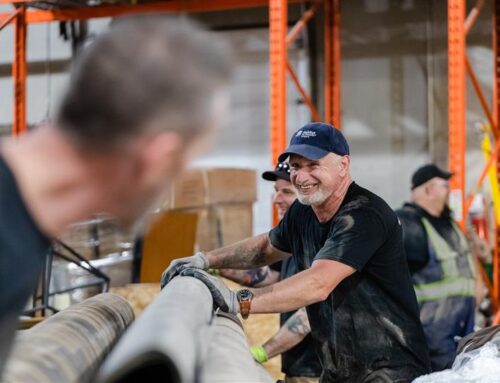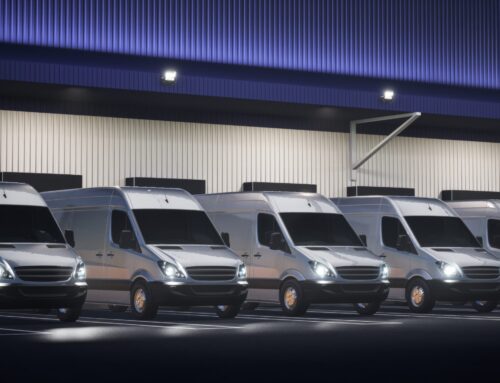PPE, or personal protective equipment, is essential for affiliate operations on jobsites and at ReStores. From gloves and ear plugs to proper clothing and shoes, PPE helps protect your employees and volunteers from physical injury, chemical exposure, environmental factors and other hazards.
Encouraging the use of PPE can help foster a culture of safety and reduce the costs your affiliate faces related to worker injuries and Workers’ Compensation and Volunteer Accident claims.
Read on to learn more about the importance of PPE and PPE best practices for Habitat affiliates.

PPE Best Practices for Habitat Jobsites
Volunteers and employees on the jobsite can come across a variety of hazards — environmental conditions, heavy machinery, hand tools and more. Your jobsite manager needs to ensure participants are prepared and protected with the right PPE.
- Hard hats and head safety
- OSHA states that employees working in areas where there is a possible danger of head injury from impact, falling or flying objects or electrical shock and burns, must be protected by protective helmets.
- Encourage the use of hard hats at all times on an active jobsite.
- Safety glasses and eye protection
- Safety glasses with shatterproof lenses can protect against dust, debris, chemicals and other foreign particles.
- Encourage the use of safety glasses at all times on an active jobsite.
- Gloves and hand protection
- Workers on jobsites can be exposed to severe cuts or lacerations, chemical burns and more.
- Provide work gloves in a variety of styles and sizes.
- Masks and respiratory protection
- Adverse health effects caused by breathing air contaminated with harmful dusts, fumes, gases, sprays, or vapors can be prevented by use of masks and respiratory protection.
- When inhalation hazards are present, encourage the use of respiratory gear. Provide a variety of options and sizes, as a proper fit is essential.
- Ear plugs and noise reduction
- Exposure to high noise levels can cause irreversible hearing loss or impairment as well as physical and psychological stress.
- Provide earplugs and earmuffs and encourage the use of hearing protection whenever there is loud or intermittent noise exposure.
- Proper clothing and footwear
- Encourage participants to wear clothes and gloves that fit and are appropriate for the work and weather conditions.
- Require work or hiking boots or sturdy shoes that protect from falling objects. Thick, non-slip soles are safest. Do not permit anyone wearing open-toed shoes or sandals on the jobsite.
Along with requiring use of PPE, consider these tips to keep employees and volunteers safe at the jobsite:
- Require all volunteers to complete the online safety course before joining on site.
- Ensure volunteer waivers are signed and collected.
- Hire employees that are good at providing instruction and supervision.
- Always ask volunteers if they are comfortable with the tasks asked of them.
- Encourage questions from volunteers.
- Review power tool safety.
- Cancel job builds when dangerous weather is forecasted.
- Provide plenty of opportunities for water and rest breaks.
- Encourage volunteers and employees to report any dangerous situation and all injuries, however minor, to the site manager.
PPE Best Practices for ReStores
While hazards on the jobsite may be more obvious, PPE is equally as important at ReStores.
- Proper clothing and footwear
- Encourage participants to wear clothes that fit and are appropriate for the work and weather conditions.
- Require work or hiking boots or sturdy shoes that protect from falling objects. Thick, non-slip soles are safest. Do not permit anyone wearing open-toed shoes or sandals to work at the ReStore.
- Gloves and hand protection
- Workers sorting ReStore donations can be exposed to severe cuts or lacerations, chemical burns and more.
- Provide work gloves in a variety of styles and sizes.
- Eye and respiratory protection
- Workers sorting ReStore donations may also be exposed to dust, mold, fumes and chemicals.
- Provide masks and protective glasses to protect workers.
- Fall protection
- When moving and storing inventory from heights four feet or higher, use personal fall protection such as harnesses and lanyards.
- Back protection
- If workers often lift heavy inventory, encourage the use of back braces and supports.
- Ensure workers are trained on the best lifting practices, including using the right equipment and knowing the limits of safe lifting.
Additional ReStore safety beyond PPE usage can include:
- Clean up any spills and wet spots right away, and place wet floor signs around wet spots until the floor is completely dry.
- Keep surfaces clean and sanitized to reduce the spread of germs.
- Have safety plans in place for emergency situations, like fires, floods, hurricanes, tornados, ice storms, active shooters and more.
- Review proper lifting procedures regularly. Ask for help if an item is too heavy to lift alone.
- Report all workplace incidents to supervisors or human resources.
- Regularly stock first-aid kits.
Additional Safety Support for Affiliates
By implementing these PPE best practices, Habitat for Humanity affiliates can create a culture of safety at jobsites and ReStores alike.
Download this PPE safety flyer to hang at your jobsites and ReStores to remind your employees and volunteers about the importance of using PPE every day.
Explore additional safety resources to protect your affiliate today.





